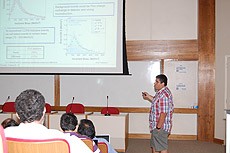Palomino Gallo first Latin American student to earn two graduate degrees on MINERvA
 |
José Luis Palomino Gallo, from Peru, earned his Ph.D. in physics at Centro Brasileiro de Pesquisas Fisicas last month, soon after presenting his research results at the recent NuInt12 workshop. He is the first student in the MINERvA Latin American collaboration to earn both his master's and doctoral degrees on the MINERvA experiment. Photo: Flavia Schaller |
The group of Latin American collaborators on the MINERvA experiment attained a new milestone recently. José Luis Palomino Gallo, from Peru, has become the first student in the collaboration to earn both his master's and, now, his doctorate on the MINERvA experiment.
"The MINERvA experiment at Fermilab has been a unique opportunity for students such as myself to learn and experience all the steps of construction, calibration, data taking and analysis of a high-energy physics experiment," José said.
José's doctoral work helped bring the MINERvA analysis of electromagnetic channels from a blank sheet to its current state of sophistication. The project involved the detection of antineutrino charged-current production of a single π0 final state, one of the more challenging topics for a detector that was just being commissioned when José began the analysis.
José's path to Fermilab began with his undergraduate studies in physics in Lima, Peru, at the Universidad Nacional de Ingeniería, a member institution of MINERvA. After earning his bachelor's, he attended another MINERvA member institution, Centro Brasileiro de Pesquisas Fisicas in Rio de Janeiro, Brazil, where he qualified for a scholarship.
In the fall of 2007, he moved to Fermilab, staying for eight months to work on MINERvA for his master's project. He then returned to Rio de Janeiro to write his thesis and take doctoral-level courses. He returned to Fermilab and, after another three-plus years, earned his doctoral degree from CBPF. The support of his wife, who has lived with him at Fermilab for the past three-and-a-half years, his advisor Hélio da Motta and his on-site mentor Jorge G. Morfín helped him achieve this milestone in MINERvA history.
"At Fermilab I had the opportunity to meet people from around the world, people with different cultures and different customs," José said. "At the end we are all talking the same language—physics." With supplemental support from the University of Pittsburgh, he finished his Ph.D.
He presented the impressive results of his doctoral project at the recent NuInt12 workshop in Rio de Janeiro.
Though his career at Fermilab is now concluding, his career as a physicist is getting a new beginning: José is on his way to Stony Brook University, having accepted a postdoc position working with Chang Kee Jung.
—Jorge Morfín, Fermilab, mentor, and Hélio da Motta, Centro Brasileiro de Pesquisas Fisicas, advisor
|